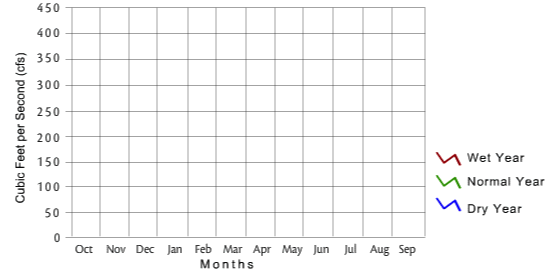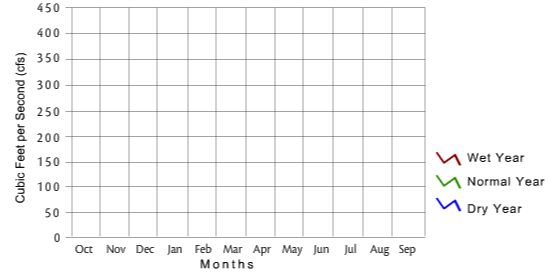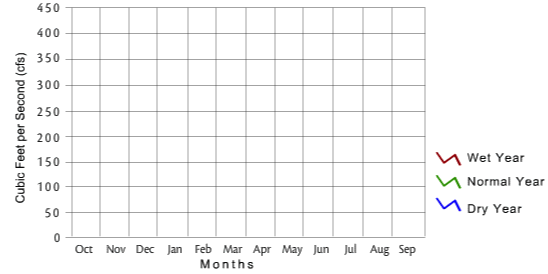The amount of water flowing in a stream and the timing of flows are key factors that define the character of floodplain riparian areas and the stream channel. In the lower Jocko, irrigation diversions have reduced channel maintenance flows (flows that maintain the channel) by as much as 50 percent from what they were historically. The reduction is higher in dry years and lower during wet years due to demands for irrigation water.
The river has responded to this overall reduction in peak flows by decreasing the amount of water the channel can convey and the amount of sediment the river can tran-sport. This, coupled with artificial straighten-ing and bank hardening, has increased stream energy in some reaches of the river, which has resulted in accelerated bank erosion, localized sediment deposition, and the formation of braided channels. Other impacts of reduced flows are warmer water and less hospitable habitats for fish.
Click the circle to play the graph.

The amount of water flowing in a stream and the timing of flows are key factors that define the character of floodplain riparian areas and the stream channel. In the lower Jocko, irrigation diversions have reduced channel maintenance flows (flows that maintain the channel) by as much as 50 percent from what they were historically. The reduction is higher in dry years and lower during wet years due to demands for irrigation water.
The river has responded to this overall reduction in peak flows by decreasing the amount of water the channel can convey and the amount of sediment the river can tran-sport. This, coupled with artificial straighten-ing and bank hardening, has increased stream energy in some reaches of the river, which has resulted in accelerated bank erosion, localized sediment deposition, and the formation of braided channels. Other impacts of reduced flows are warmer water and less hospitable habitats for fish.
Click the circle to play the graph.

The amount of water flowing in a stream and the timing of flows are key factors that define the character of floodplain riparian areas and the stream channel. In the lower Jocko, irrigation diversions have reduced channel maintenance flows (flows that maintain the channel) by as much as 50 percent from what they were historically. The reduction is higher in dry years and lower during wet years due to demands for irrigation water.
The river has responded to this overall reduction in peak flows by decreasing the amount of water the channel can convey and the amount of sediment the river can tran-sport. This, coupled with artificial straighten-ing and bank hardening, has increased stream energy in some reaches of the river, which has resulted in accelerated bank erosion, localized sediment deposition, and the formation of braided channels. Other impacts of reduced flows are warmer water and less hospitable habitats for fish.
Click the circle to play the graph.
